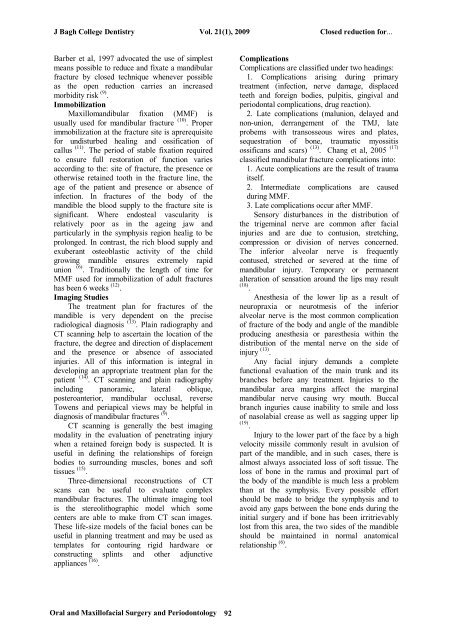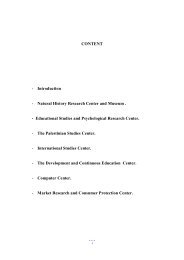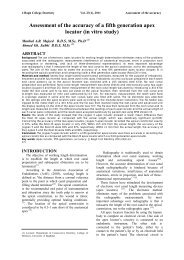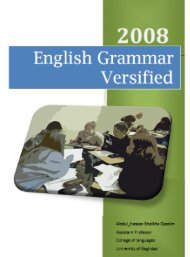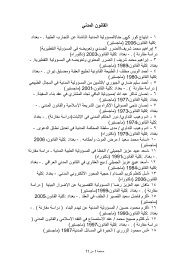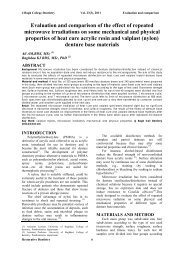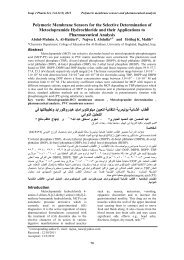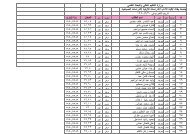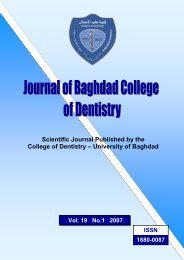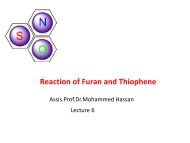Vol 21 No. 1
Vol 21 No. 1
Vol 21 No. 1
Create successful ePaper yourself
Turn your PDF publications into a flip-book with our unique Google optimized e-Paper software.
J Bagh College Dentistry <strong>Vol</strong>. <strong>21</strong>(1), 2009 Closed reduction for...<br />
Barber et al, 1997 advocated the use of simplest<br />
means possible to reduce and fixate a mandibular<br />
fracture by closed technique whenever possible<br />
as the open reduction carries an increased<br />
morbidity risk (9) .<br />
Immobilization<br />
Maxillomandibular fixation (MMF) is<br />
usually used for mandibular fracture (10) . Proper<br />
immobilization at the fracture site is aprerequisite<br />
for undisturbed healing and ossification of<br />
callus (11) . The period of stable fixation required<br />
to ensure full restoration of function varies<br />
according to the: site of fracture, the presence or<br />
otherwise retained tooth in the fracture line, the<br />
age of the patient and presence or absence of<br />
infection. In fractures of the body of the<br />
mandible the blood supply to the fracture site is<br />
significant. Where endosteal vascularity is<br />
relatively poor as in the ageing jaw and<br />
particularly in the symphysis region healig to be<br />
prolonged. In contrast, the rich blood supply and<br />
exuberant osteoblastic activity of the child<br />
growing mandible ensures extremely rapid<br />
union (6) . Traditionally the length of time for<br />
MMF used for immobilization of adult fractures<br />
has been 6 weeks (12) .<br />
Imaging Studies<br />
The treatment plan for fractures of the<br />
mandible is very dependent on the precise<br />
radiological diagnosis (13) . Plain radiography and<br />
CT scanning help to ascertain the location of the<br />
fracture, the degree and direction of displacement<br />
and the presence or absence of associated<br />
injuries. All of this information is integral in<br />
developing an appropriate treatment plan for the<br />
patient (14) . CT scanning and plain radiography<br />
including panoramic, lateral oblique,<br />
posteroanterior, mandibular occlusal, reverse<br />
Towens and periapical views may be helpful in<br />
diagnosis of mandibular fractures (9) .<br />
CT scanning is generally the best imaging<br />
modality in the evaluation of penetrating injury<br />
when a retained foreign body is suspected. It is<br />
useful in defining the relationships of foreign<br />
bodies to surrounding muscles, bones and soft<br />
tissues (15) .<br />
Three-dimensional reconstructions of CT<br />
scans can be useful to evaluate complex<br />
mandibular fractures. The ultimate imaging tool<br />
is the stereolithographic model which some<br />
centers are able to make from CT scan images.<br />
These life-size models of the facial bones can be<br />
useful in planning treatment and may be used as<br />
templates for contouring rigid hardware or<br />
constructing splints and other adjunctive<br />
appliances (16) .<br />
Complications<br />
Complications are classified under two headings:<br />
1. Complications arising during primary<br />
treatment (infection, nerve damage, displaced<br />
teeth and foreign bodies, pulpitis, gingival and<br />
periodontal complications, drug reaction).<br />
2. Late complications (malunion, delayed and<br />
non-union, derrangement of the TMJ, late<br />
probems with transosseous wires and plates,<br />
sequestration of bone, traumatic myossitis<br />
ossificans and scars) (13) . Chang et al, 2005 (17)<br />
classified mandibular fracture complications into:<br />
1. Acute complications are the result of trauma<br />
itself.<br />
2. Intermediate complications are caused<br />
during MMF.<br />
3. Late complications occur after MMF.<br />
Sensory disturbances in the distribution of<br />
the trigeminal nerve are common after facial<br />
injuries and are due to contusion, stretching,<br />
compression or division of nerves concerned.<br />
The inferior alveolar nerve is frequently<br />
contused, stretched or severed at the time of<br />
mandibular injury. Temporary or permanent<br />
alteration of sensation around the lips may result<br />
(18) .<br />
Anesthesia of the lower lip as a result of<br />
neuropraxia or neurotmesis of the inferior<br />
alveolar nerve is the most common complication<br />
of fracture of the body and angle of the mandible<br />
producing anesthesia or paresthesia within the<br />
distribution of the mental nerve on the side of<br />
injury (13) .<br />
Any facial injury demands a complete<br />
functional evaluation of the main trunk and its<br />
branches before any treatment. Injuries to the<br />
mandibular area margins affect the marginal<br />
mandibular nerve causing wry mouth. Buccal<br />
branch inguries cause inability to smile and loss<br />
of nasolabial crease as well as sagging upper lip<br />
(19) .<br />
Injury to the lower part of the face by a high<br />
velocity missile commonly result in avulsion of<br />
part of the mandible, and in such cases, there is<br />
almost always associated loss of soft tissue. The<br />
loss of bone in the ramus and proximal part of<br />
the body of the mandible is much less a problem<br />
than at the symphysis. Every possible effort<br />
should be made to bridge the symphysis and to<br />
avoid any gaps between the bone ends during the<br />
initial surgery and if bone has been irritrievably<br />
lost from this area, the two sides of the mandible<br />
should be maintained in normal anatomical<br />
relationship (6) .<br />
Oral and Maxillofacial Surgery and Periodontology<br />
92


